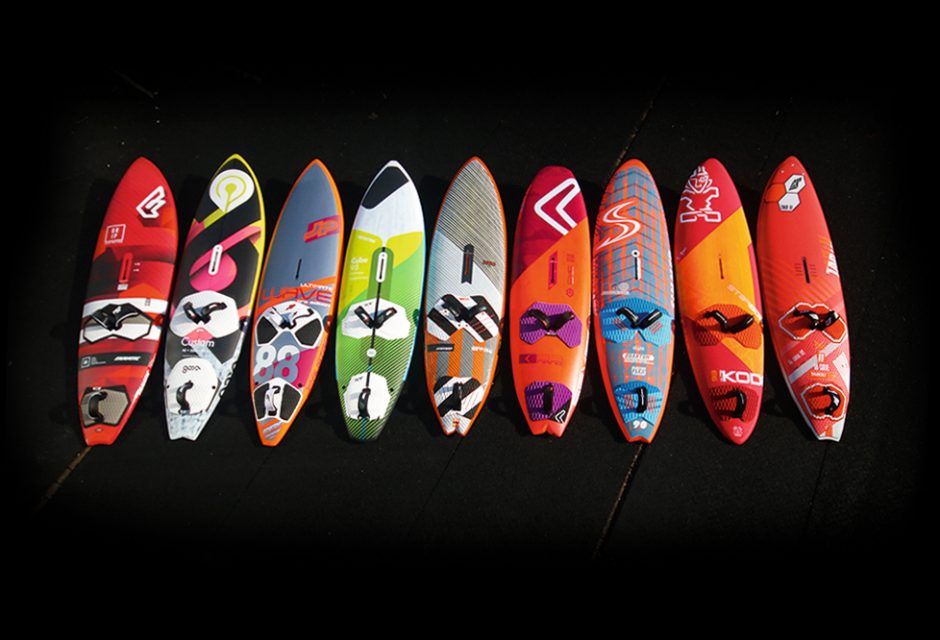THE NEW ‘GO TO’ SIZE
90L WAVE BOARD TEST 2019
Test Editor Tris Best // Second Testers Maurin Rottenwalter, Joe North, Dan Hallam, Dan Linton & Tom Squires
Photos Tris Best // Test location Kimmeridge, Rhosneigr,
Overcombe & Daymer Bay
Another season starts and another crop of the latest and greatest wave boards land on our doorstep to try. There are certainly worse jobs in the world! After what has seemed like an eternity waiting for the winds to return this summer, at last the high pressure broke and low pressures rumbled in from the Atlantic, giving the team and I the chance to put 2019’s 90 litre wave boards through their paces on UK shores.
This test was originally published in the October 2018 issue.
FINDINGS
We chose to test 90 litre wave boards this year for the simple reason that many brands are sensibly adopting a two year life cycle for their ranges, so we’d be going over raked ground if we were to test 85 litre boards like last year. The quandary arose when the choice was to specify compact or conventional designs … a really tough vote, which we ultimately left for the brands to decide themselves. Not surprisingly, most opted for convention.
Ninety litre boards were once classed as the ‘big daddies’ of a discerning wave rider’s quiver; the boards of the larger rider, that to others felt like a forced compromise when the 80 litre board was just too impractical. The introduction of multi-fin options has totally changed the landscape of wave board design, enabling large boards to behave much more akin to their smaller siblings. And in the gusty, variable conditions we experience here in the UK thanks to our frontal weather patterns, using a larger board can transform a typical session. In gusty marginal winds it could be the difference between an average sail with a few golden powered minutes but bogging the rest of the time … or comfortable float and ride with enough release to catch double the number of waves.
Whilst testing in Rhosneigr the wind continued to increase on one day, from being marginally powered on 5.0m sails to overpowered on 4.2m. And I have to say, we were mightily impressed with just how well mannered these 90 litre boards were in challenging seas. Most importantly we didn’t feel at any disadvantage or over-boarded whilst dropping into a wave or asking them to respond in an instant. Yes, perhaps they felt a little larger and bulky in the air when compared to their smaller siblings … but the advantage swung back the other way when the clouds darkened and the wind turned off as the next front approached.
General developments and trends amongst the brands for 2019 is a lust for speed and early planing by straightening rockers, countering any loss in turning potential by the introduction of other measures. This could be the reduction of tail thicknesses, narrowing of tail widths, thinning of rails, shortening of rail-lengths, or the rearwards movement of the rider’s stance. Or any combination of the above! The multi-fin debate between quad, thruster or twinzer is still roaring on, and rightly so. It is such a critical part to the feel of the board, so much so that we could honestly spend an extra six months testing these boards with countless fin combinations and still have a way to go. The fins supplied are unquestionably a good place to start. If you aren’t getting the results you want for the conditions you’re sailing in, a change in setup, fin size or stiffness could transform the riding sensation you experience.
SUMMARY
Going through the boards in the group, let’s start with some of the more conventional designs here. Whilst a new design, the Tabou Da Curve is all about speed and carrying it through fast, committed front-footed power carves. It can of course play in slow onshore waves as well, but you find yourself hunting for bigger cleaner faces to plough the rails into again. It’s such an addictive sensation! The same can be said of the Starboard, albeit the UltraKode is much more planted in nature, the slower entry and drive through the tail of the board helping it to hook through tighter turns if you push hard.
At the other end of the scale is the Nano from Severne – a back-foot biased demon with a naturally narrower stance and altogether different feel from most here. Dial it in and the board is incredible for making the most impossible of tight turns, stamping on the tail to send it vertically back up the face.
The Quatro Cube also favours a back-foot based riding style, its dedicated quad setup providing just the right balance of grip and response to make it useful in any wave environment. But the real surprise with the Cube was its ease of use and practicality – something we weren’t necessarily expecting from such a wave committed brand. If plug and play ease is your focus, the Goya must be a top consideration. It is just so fun and rewarding to use, inspiring you to push throughout a session as you just know that it will back you.
The JP Ultimate Wave comes from very different stock, and demands you remain focused, particularly in challenging conditions. But put the time in to find the right balance and setup … and the reward is worth the effort. It has such a crisp and engaging feel that it is sure to satisfy even the most exacting pilot. The RRD has a similar stance and connection with the water in many ways, yet with a more sedate and amenable persona. Big and floaty, it likes bold movements and can be played on both feet, thriving on being driven hard. The all-rounders of the group are the Simmer Quantum and Fanatic Grip. Both plane easily, remain user-friendly over a massive wind range, and have the versatility to suit a diverse number of rider weights and styles. The Quantum is a little wider in the tail and was more useful in marginal winds, whereas the Grip was just so rewarding to use when the chips were down and conditions turned on.
The truth is that there really isn’t a bad board in this group. Posing the question amongst the test team, there wasn’t a single board here that we’d be disappointed with, if we were forced to use it for the season. And that goes for every member of the test team, with four very different riding styles and requirements. Quite a telling result! So which board do you choose? The wave board category is more subjective than any other category we test, so the starting point to answer that question is to ask yourself a few extra preliminaries, such as where you sail; what conditions you’re likely to sail in and what style of sailing you prefer? Answer those honestly and it will lead you down the path to your ideal partner.
One last point to ponder: For the average weight rider an 85 litre wave board has long been the ‘go-to’ size if just one board remained in your quiver. But just as developments in sail design (reduced luff curves and batten numbers) are enabling people to reduce sail sizes (and possibly even numbers) in their quivers (from 5.3 / 4.7 / 4.2 / 3.7 to 5.0 / 4.5 / 4.0), could it be that the life and versatility that multi-fin options has breathed into wave board design enables the go-to size to increase? Sure, if you can afford two boards then an 85 and 95/100 litre would be the dream … but if you were limited to choosing one, could the 90 litre become the new benchmark? That extra little bit of volume would provide freedom and stability for float and ride, whilst it still feels small and controllable in overpowered 4.2m weather. Does this expanded wind range provide the crucial practicality for you to deal more sensibly with our country’s typically variable winds? Over to you.
THE LINE UP
• STARBOARD ULTRAKODE FLAX BALSA 93


